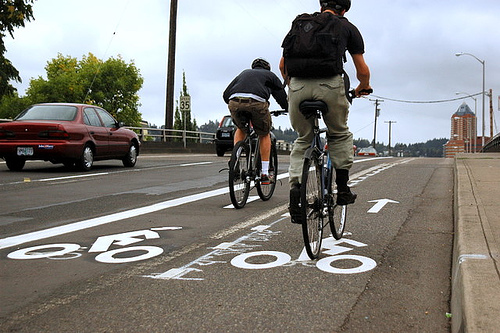
By Jada Brazell
The Dallas City Council adopted the Dallas Bike Plan last year, but without public advocacy and funding, the plan amounts to little more than lines on a map.
That’s why Councilmember Scott Griggs encourages Dallas residents to attend upcoming town hall meetings and urge city councilmembers to earmark bike lane funding in the upcoming bond program. The bond program will be included in the November presidential election, and if bike lanes are part of the program and the bond passes, those map lines will physically make their way to Dallas streets.
Residents who missed town hall meetings in their districts may individually contact councilmembers to vocalize support of the bike lanes, Griggs said, noting that all input must be received by August.
Currently, four segments of the plan – each in Oak Cliff – are underway. The Jefferson Boulevard Viaduct, a 1.5-mile lane, will connect Bishop Arts to downtown Dallas. Completion date for the $157,000 project is estimated for the fall, according to Griggs’ website.
He said the next project slated for completion is near Rosemont Elementary. This project should begin in the fall and finish in spring of 2013.
Lanes on Kings Highway, which will nearly connect to the Rosemont lanes, will be developed next, followed by lanes on Fort Worth Avenue. The City is still seeking funding for the Fort Worth Avenue project, but the two lanes are slated for development in fall 2012-spring 2013, Griggs said.
He said funding for the approved projects has come from a couple of sources, including tax increment financing and surpluses from completed projects. The city also is using money allocated for street striping to create several lanes.
Bike lane installation is divided into three categories: near-term, medium-term and long-term implantation. Near-term implementation projects comprise approximately 80 miles of the total plan and focus on the downtown and surrounding areas.
While the approved projects amount only to about six miles, plan development is still in its early stages. Development requires a lengthy process of engineering, design, bid proposals and funding. Griggs said the entire plan, which includes more than 800 miles of on-street facilities, will take 10 to 20 years to fully develop.
The first step in development is to find funding and review the plan to determine the most feasible possibilities, Griggs said. Once the council agrees to allocate funding for a specific lane project, the design and implementation processes begin. Everything outsourced goes out for bid, a process that could take months, depending on the scope of the project. The Council reviews pricing, scope and legal requirements before voting on the bid.
Griggs is optimistic that with public support and funding, the Dallas Bike Plan will become a reality. “We’re already starting to get traction,” he said.
Griggs said the City is also making progress on off-street trails in 2012, having created more than 10 miles of pedestrian-friendly paths: “We’ve opened several major trail systems,” he said.
Interested Dallas residents who want to learn more about the town hall meetings and the 2012 Capital Bond Program can visit http://2012bondprogram.dallascityhall.com/.
Jada Brazell is a freelance writer who also consults for fashion- and art-based businesses on branding. She has written for the Odessa American and Global Fashion News, edited for the Texas Senate and RadioShack, and contributed to several magazines and newspapers in Central and South Texas.









